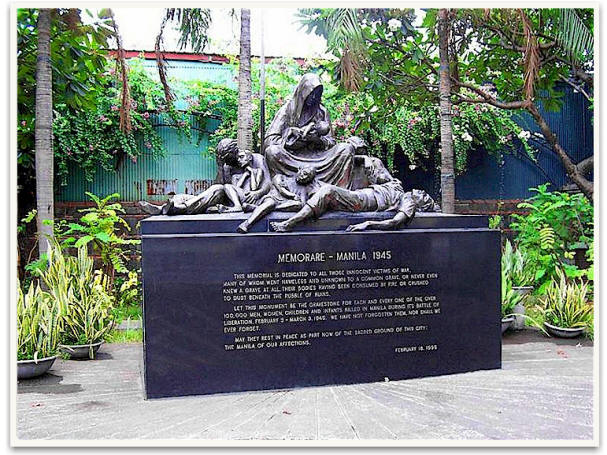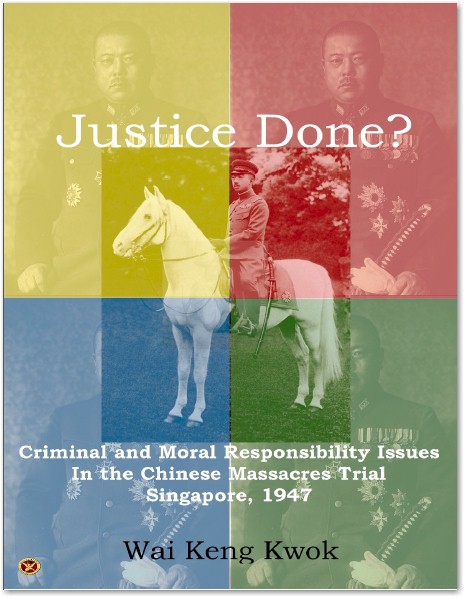|
Along the way, on Rizal Avenue, I saw many GIs in full battle gear being
mobbed by street urchins who were shouting “Victory Joe, you want a
pom-pom Joe?” as they tried to cadge a Hershey chocolate bar from them.
Along the way, there were already a few bars and make-shift halls with
banners announcing girlie shows. As we walked past one of them,
I could hear the last refrain of the song “You Are My Sunshine”
followed by the melodious but
melancholy voices of the Mills Brothers singing “I Want to Buy a Paper
Doll That I Can Call My Own.”
After days of searching, we finally found my mother at the San Lazaro
Hospital. She had received proper treatment but her left arm had been
fractured and peppered with shrapnel, her left eye injured by tiny stone
particles, but the infection that had set in on her injured left arm,
which could have caused its amputation, was fortunately arrested on time.
Even after sixty-four years after the Battle of Manila had ended, long
repressed memories still surface unbidden in my mind. The smell of rotting
flesh, the pangs of hunger and of thirst, and the fear of death still
haunt me in many unguarded moments. Memories bring me back to February 17,
1945, our day of liberation, but unknown to us then, a day also that
marked the merciless massacre of civilians by Japanese marines at the
house of Dr. Rafael Moreta, our neighbor at Isaac Peral Street. I often
think and remember Mr. Andy Cang and his loving wife Remedios, whose
generosity and kindness helped us survive those last harrowing days at the
PGH. I think of that kind
American officer who gave us water from his canteen, and I wonder if he
too survived the Battle of Manila.
I think of the hapless crew of that B-24 Liberator shot down over Manila
on January 8, 1945, whose fate I learned only in 2002 when, after sixty
years, I met Sascha Jean
Jansen nee Weinzheimer again when she returned on a sentimental journey
with an American tour group of former American Manila residents interned
at the UST. Sascha also saw
the downing of this B-24 from her shanty at the UST where she was
interned. She spent time researching the identity of that B-24 and its
crew and discovered that this B-24 Liberator, with serial number 44-40553,
belonged to the 307th Bombardment Group (H) known as the “Long Rangers.”
When it was shot down on January 8, 1945, it had just flown in from its
base in Ambon, the Moluccas, and had just finished its bombing run over
Nielsen Field (now all of Ayala Avenue, Makati Avenue, and Paseo de Roxas
in Makati City) All of its crew of eleven were killed, including that lone
parachutist who was shot and murdered while dangling in the air over
Ermita. The pilot of this B-24 was 2nd Lt John D. Lucey and his co-pilot
was 2nd Lt. William O. Goodlow. Their remains now rest in the Manila
American Cemetery at Fort Boniface, formerly Fort Wm. McKinley.
But more than anyone else, I always think of Narda, the poor unfortunate
girl, just in her early teens, barely an adult when she was killed at the
age of fifteen. She held such great promise. She was in her third year of
high school at the Philippine Women’s University where she always finished
at the top of her class. She was the hope of her poor peasant family. And
in a flash, this hope was dashed, gone forever, in a cruel twist of fate.
I often wonder what had happened to her remains. Narda has no grave that
anyone can visit to lay flowers in memory of her tragic death; no
gravestone to mark the end of a promising life until Memorare Manila,
under the untiring leadership of Ambassador Juan “Johnny” Rocha, erected
in Intramuros, on February 18, 1995, an elegant and heart wrenching
memorial, very much like Michelangelo’s Pieta, to honor the memory of all
the innocent civilians who died during the Battle of Manila. Its moving
inscription reads:

"This memorial is dedicated to all those
innocent victims of war, many of whom went nameless and unknown to a
common grave, or even never knew a grave at all, their bodies having been
consumed by fire or crushed to dust beneath the rubble of ruins."
"Let this monument be the gravestone for each and
every one of the over 100,000 men, women, children and infants killed in
Manila during its battle of liberation, February 3 - March 3, 1945. We
have not forgotten them, nor shall we ever forget."
"May they rest in peace as part now of the sacred
ground of this city: the Manila of our affections."
Jim Litton
This article first appeared on the Battling Bastards of Bataan Website
|

